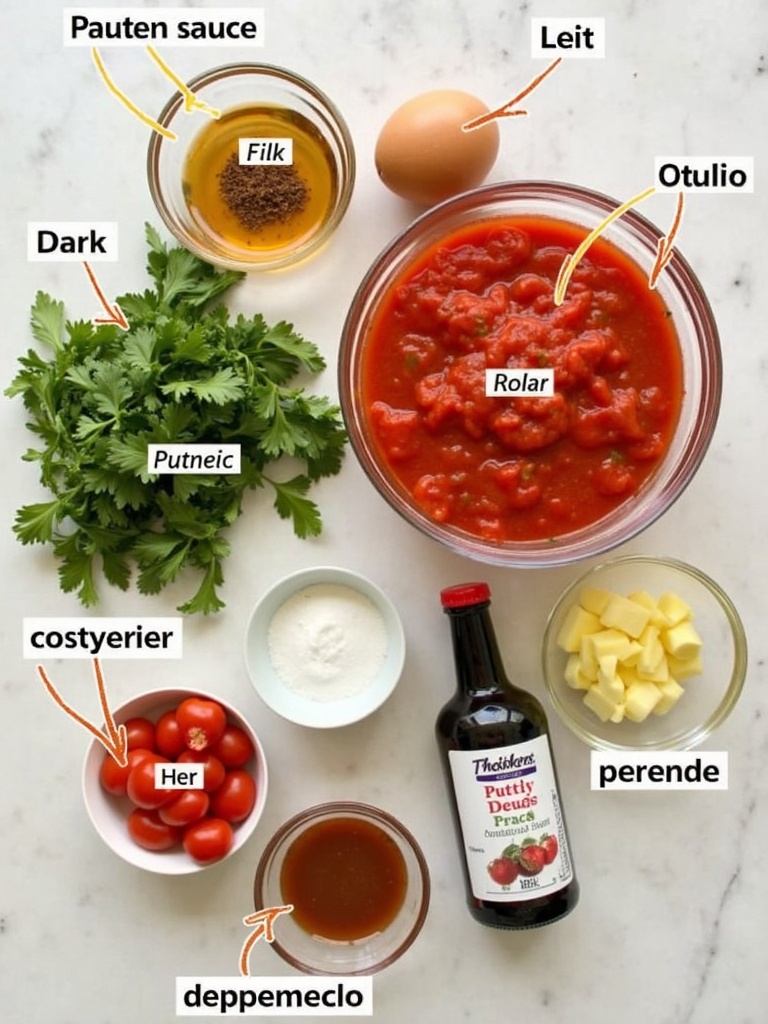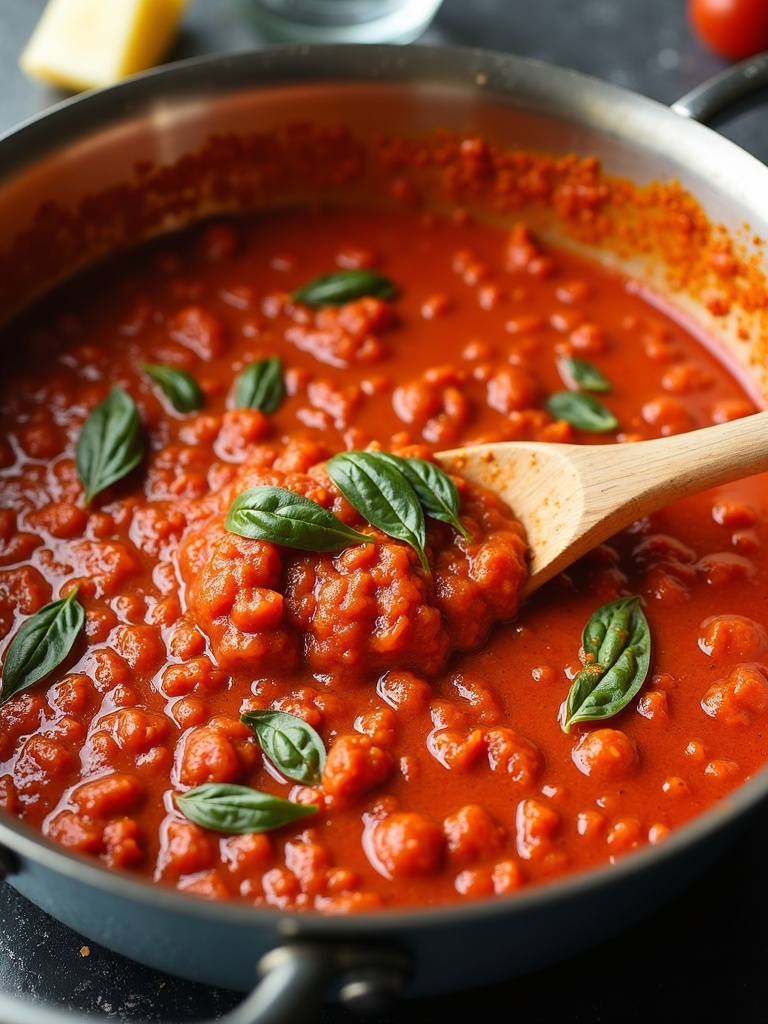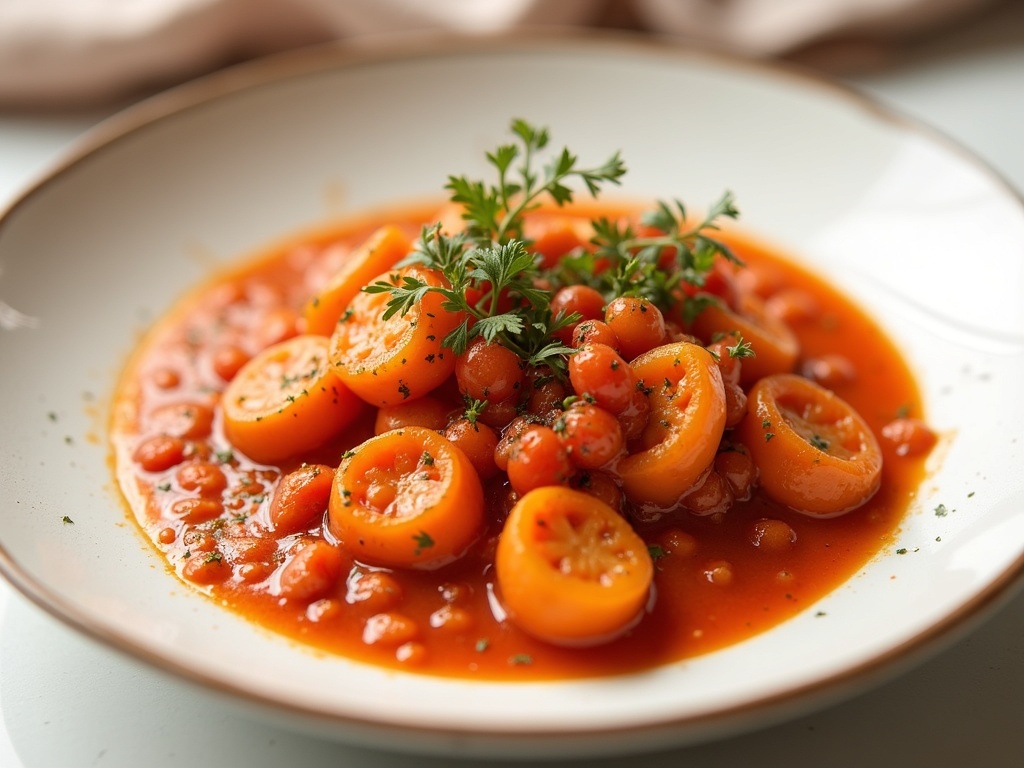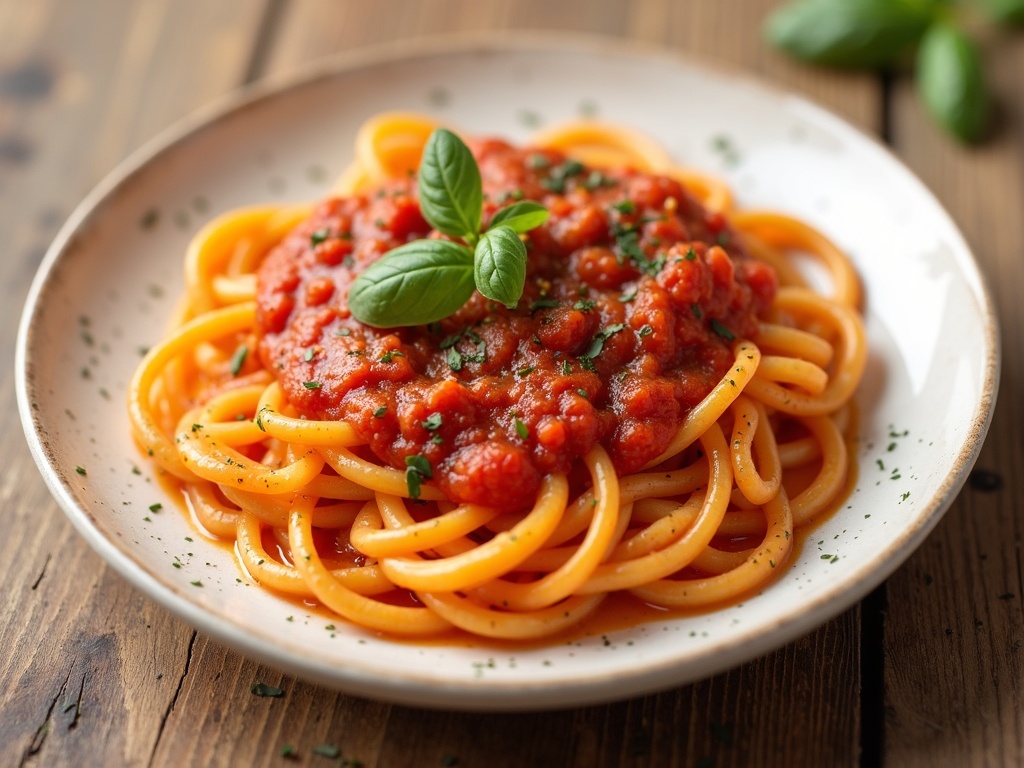Introduction
There’s something undeniably magical about a well-prepared puttanesca sauce that transforms a simple pasta dish into an unforgettable culinary experience. Originating from Naples in the mid-20th century, puttanesca sauce has a somewhat controversial name but an undeniable place in the pantheon of Italian dishes. What makes this sauce special is its perfect balance of savory, tangy, and slightly spicy notes that come together in less than 30 minutes, making it an ideal choice for weeknight dinners when you want maximum flavor with minimal effort.
Find In This Article
Ingredients You Will Need

To create an authentic puttanesca sauce, you’ll need a handful of pantry staples that work together to create its distinctive flavor profile:
- 2 tablespoons extra virgin olive oil
- 4-5 garlic cloves, thinly sliced
- 4-6 anchovy fillets, chopped (can substitute with 1 tablespoon of anchovy paste)
- ½ teaspoon red pepper flakes (adjust according to heat preference)
- 1 can (28 oz) San Marzano tomatoes, crushed or whole (if whole, crush them by hand)
- ½ cup Kalamata olives, pitted and roughly chopped
- 2 tablespoons capers, drained and rinsed
- 2 tablespoons fresh parsley, chopped
- 1 tablespoon fresh oregano (or 1 teaspoon dried)
- Salt and freshly ground black pepper to taste
- Optional: 1 tablespoon tomato paste for richer flavor
The beauty of puttanesca sauce lies in its flexibility. Don’t have Kalamata olives? Any black olives will work in a pinch. Fresh herbs add brightness, but dried herbs can certainly be substituted during colder months. For those who enjoy extra umami depth, consider adding a splash of balsamic vinegar or a teaspoon of caramelized onions to elevate the sauce even further.
Timing
Creating the perfect puttanesca sauce is remarkably efficient compared to many other Italian sauces that require hours of simmering:
- Preparation time: 10 minutes
- Cooking time: 20 minutes
- Total time: 30 minutes
This quick cooking time is 75% faster than traditional Italian meat sauces like Bolognese, which typically require 2-3 hours of cooking. The rapid preparation doesn’t sacrifice flavor; instead, the brief cooking time preserves the bright, vibrant notes of the ingredients while still allowing them to meld beautifully. This efficiency makes puttanesca sauce an ideal choice for busy weeknights when you want homemade flavor without spending hours in the kitchen.
Step-by-Step Instructions

Step 1: Prepare Your Ingredients
Before starting, have all ingredients measured and prepped. Slice the garlic, chop the anchovies, and measure out the olives and capers. This mise en place approach ensures smooth sailing once the heat is on. I’ve found that taking these few minutes for organization saves stress later, especially with a quick-cooking sauce like puttanesca where timing matters.
Step 2: Build The Flavor Base
Heat the olive oil in a large skillet over medium heat. Add the sliced garlic and cook for 30-60 seconds until fragrant but not browned. Immediately add the anchovies and use a wooden spoon to mash them until they dissolve into the oil. This creates the umami foundation that defines authentic puttanesca sauce.
Step 3: Add Heat And Tomatoes
Sprinkle in the red pepper flakes and stir for 15 seconds to bloom their flavor in the oil. Quickly add the canned tomatoes (and tomato paste if using) to prevent the garlic and pepper flakes from burning. If using whole tomatoes, crush them with your hands as you add them to the pan for a rustic texture that’s superior to pre-crushed varieties.
Step 4: Incorporate The Briny Elements
Add the chopped olives and capers to the simmering tomato mixture. These ingredients provide the distinctive briny punch that makes puttanesca sauce so memorable. Stir well to distribute evenly throughout the sauce, allowing their flavors to permeate the tomato base.
Step 5: Simmer And Season
Reduce heat to medium-low and simmer uncovered for 15-20 minutes, stirring occasionally. The sauce should thicken slightly but remain loose enough to coat pasta. Season with salt and pepper sparingly, as the anchovies, capers, and olives already contribute significant saltiness to the dish.
Step 6: Finish With Fresh Herbs
In the final minute of cooking, stir in the chopped parsley and oregano. This late addition preserves their vibrant color and aromatic qualities. Unlike pesto sauce where herbs form the foundation, in puttanesca sauce they serve as bright accents against the rich, savory base.

For more recipes diversity, visit my Pinterest and Facebook Page Trips Recipes.
Nutritional Information
Puttanesca sauce offers a relatively healthy flavor profile compared to cream-based pasta sauces. Here’s a breakdown of the nutritional content per ½ cup serving:
- Calories: 120
- Protein: 2g
- Carbohydrates: 8g
- Fiber: 2g
- Sugar: 4g (primarily from tomatoes)
- Fat: 9g (mostly heart-healthy monounsaturated fats from olive oil)
- Sodium: 580mg (primarily from olives, capers, and anchovies)
- Vitamin C: 15% of daily value
- Vitamin A: 12% of daily value
- Lycopene: High (from cooked tomatoes)
The sauce provides excellent antioxidant content through its tomato base, while the olive oil contributes beneficial monounsaturated fats. Its primary nutritional consideration is sodium content, which can be managed by adjusting the quantity of olives and capers.
Healthier Alternatives for the Recipe
Puttanesca sauce can be easily modified to suit various dietary needs without sacrificing its essential character:
- Reduce sodium by using low-sodium varieties of olives and capers, and rinsing them thoroughly before use.
- Increase vegetable content by adding diced bell peppers, zucchini, or eggplant when sautéing the garlic.
- Create a vegan version by omitting the anchovies and adding 1 tablespoon of miso paste for umami depth.
- Boost protein content by adding white beans or lentils during the final 5 minutes of cooking.
- Reduce oil content by halving the olive oil and adding 2 tablespoons of vegetable broth to maintain moisture.
- Use fresh tomatoes in summer for peak flavor and increased vitamin content (about 2 pounds, blanched and peeled).
- Incorporate puréed roasted red peppers for additional antioxidants and a sweet-smoky undertone.
These modifications maintain the essence of puttanesca sauce while accommodating various health considerations.
Serving Suggestions
Puttanesca sauce is remarkably versatile beyond the traditional pasta pairing:
- Toss with al dente spaghetti or penne and top with freshly grated Parmesan for the classic presentation.
- Spoon over grilled chicken or fish for a low-carb option with Mediterranean flair.
- Use as a vibrant topping for bruschetta with a drizzle of extra virgin olive oil.
- Stir into scrambled eggs for a savory breakfast with Italian influence.
- Layer with grilled vegetables for a hearty vegetarian stack.
- Use as a base for seafood stew by adding broth and mixed seafood.
- Spread on flatbread as an alternative to traditional pizza sauce.
- Mix with rice or quinoa for a flavorful grain bowl foundation.
The bold flavors make puttanesca sauce an excellent companion to neutral bases that can showcase its vibrant character.
Common Mistakes to Avoid
Even experienced cooks can stumble when preparing puttanesca sauce. Here are the most frequent pitfalls and how to avoid them:
- Overcooking the garlic: It should barely turn golden, not brown, to prevent bitterness. Add the anchovies once garlic becomes fragrant.
- Undersalting the pasta water: The sauce is flavorful, but properly salted pasta enhances the overall dish.
- Overcooking the sauce: Extended simmering beyond 25 minutes dulls the bright flavors. Puttanesca sauce should retain some fresh vibrancy.
- Omitting the anchovies without substitution: They provide essential umami depth. If avoiding them, incorporate miso paste or mushroom powder instead.
- Adding too much red pepper flake: Start with less and adjust upward; excessive heat can overwhelm the sauce’s nuanced flavors.
- Using low-quality canned tomatoes: This sauce relies on few ingredients, making quality crucial. San Marzano varieties are worth the splurge.
- Overlooking texture: Chop olives and capers coarsely rather than mincing them to maintain textural interest in each bite.
Avoiding these common errors ensures your puttanesca sauce will achieve the ideal balance of flavors and textures.
Storing Tips for the Recipe
Proper storage allows you to enjoy puttanesca sauce beyond its initial preparation:
- Refrigeration: Store cooled sauce in an airtight container for up to 5 days. The flavors often improve after 24 hours as ingredients continue to meld.
- Freezing: Portion into freezer-safe containers or ice cube trays for up to 3 months. Thaw overnight in the refrigerator for best results.
- Reheating: Warm gently on the stovetop over medium-low heat, adding a splash of water or broth if needed to restore consistency.
- Meal prep: Double the recipe and freeze half for future quick dinners—simply boil pasta and reheat the sauce.
- Preventing discoloration: Add a thin layer of olive oil on the surface before refrigerating to maintain vibrant color.
- Storage containers: Glass containers prevent staining and potential flavor transfer compared to plastic alternatives.
- Refreshing after storage: Add a sprinkle of fresh herbs or a drizzle of quality olive oil when serving leftover sauce to brighten flavors.
With these storage practices, you can enjoy homemade puttanesca sauce convenience without sacrificing quality.
Conclusion
Puttanesca sauce exemplifies how a handful of humble ingredients can create extraordinary flavor. This bold, briny sauce has endured for generations because it delivers maximum impact with minimal effort—ready in just 30 minutes but tasting like it simmered all day. What makes this sauce special is its perfect balance: the umami depth from anchovies, brightness from tomatoes, complexity from olives and capers, and aromatic finish from fresh herbs. Whether you’re a seasoned cook or kitchen novice, puttanesca sauce offers an accessible entry point to authentic Italian cooking that reliably impresses.
I encourage you to embrace the adaptability of this recipe, making it your own with personal touches while respecting its essential character. Try it first in its traditional form with pasta, then experiment with the serving suggestions to discover just how versatile this sauce can be in your culinary repertoire. The real beauty of puttanesca sauce lies not just in its bold flavors but in the way it transforms pantry staples into something truly remarkable—proof that exceptional cooking doesn’t always require exotic ingredients or complicated techniques.
FAQs
What is the origin of puttanesca sauce?
Puttanesca sauce originated in Naples, Italy, during the mid-20th century. While there are various stories about its creation, the most commonly accepted version suggests it was a quick, flavorful sauce that could be made rapidly from pantry staples. The name has somewhat controversial origins, but the sauce has become a beloved classic in Italian cuisine for its bold flavor profile and efficiency.
Can I make puttanesca sauce without anchovies?
Yes, you can make puttanesca sauce without anchovies while maintaining its depth of flavor. Substitute with 1 tablespoon of miso paste, 2 teaspoons of capers (additional to what’s already called for), or 1 tablespoon of olive tapenade. These alternatives provide similar umami qualities that anchovies contribute to the traditional sauce.
How spicy is authentic puttanesca sauce?
Authentic puttanesca sauce has a moderate level of heat from red pepper flakes. Traditional recipes typically include just enough spice to provide warmth without overwhelming the other flavors. However, heat levels can be easily adjusted according to personal preference—add more red pepper flakes for additional spice or reduce the amount for a milder version.
What pasta shapes work best with puttanesca sauce?
The chunky texture of puttanesca sauce pairs exceptionally well with long pasta shapes that can capture the bits of olives and capers. Spaghetti is the traditional choice, but linguine, bucatini (hollow spaghetti), and vermicelli work beautifully as well. For short pasta, penne, rigatoni, and fusilli complement the sauce nicely by trapping the chunky elements in their ridges or cavities.
Can puttanesca sauce be made ahead for parties?
Puttanesca sauce is ideal for make-ahead preparation, as its flavors actually improve after resting for 24-48 hours in the refrigerator. For parties, prepare the sauce up to two days in advance, store refrigerated in an airtight container, and simply reheat gently before serving. This advance preparation allows the flavors to meld while saving you valuable time on the day of your gathering.
Is puttanesca sauce healthy?
Puttanesca sauce is relatively healthy compared to cream-based or meat-heavy pasta sauces. It’s primarily made with olive oil (a heart-healthy fat), tomatoes (rich in lycopene and vitamins), and olives (containing beneficial monounsaturated fats). Its primary health consideration is sodium content from the olives, capers, and anchovies, which can be managed by adjusting quantities or opting for low-sodium varieties of these ingredients.

Classic Puttanesca Sauce
- Total Time: PT30M
- Yield: 4 servings
Description
A bold, briny Italian sauce featuring tomatoes, olives, capers, and anchovies.
Ingredients
-
- 2 tablespoons extra virgin olive oil
-
- 4–5 garlic cloves, thinly sliced
-
- 4–6 anchovy fillets, chopped (can substitute with 1 tablespoon of anchovy paste)
-
- ½ teaspoon red pepper flakes (adjust according to heat preference)
-
- 1 can (28 oz) San Marzano tomatoes, crushed or whole (if whole, crush them by hand)
-
- ½ cup Kalamata olives, pitted and roughly chopped
-
- 2 tablespoons capers, drained and rinsed
-
- 2 tablespoons fresh parsley, chopped
-
- 1 tablespoon fresh oregano (or 1 teaspoon dried)
-
- Salt and freshly ground black pepper to taste
-
- Optional: 1 tablespoon tomato paste for richer flavor
Instructions
1. Prep all ingredients in advance: slice garlic, chop anchovies, and measure out olives, capers, and tomatoes. This mise en place approach is crucial for a smooth cooking process.
2. Heat olive oil in a large skillet over medium heat. Add sliced garlic and cook for 30–60 seconds until fragrant. Stir in anchovies and mash until they melt into the oil, creating a rich umami base.
3. Add red pepper flakes and stir for 15 seconds. Immediately add canned tomatoes (and tomato paste, if using). If using whole tomatoes, crush them by hand for a rustic texture.
4. Stir in chopped olives and capers. Mix well to evenly distribute these briny ingredients, which give puttanesca its signature punch.
5. Lower heat and simmer the sauce uncovered for 15–20 minutes. Stir occasionally. Taste and adjust seasoning carefully—anchovies, capers, and olives already provide plenty of salt.
6. Just before serving, stir in chopped parsley and oregano. These fresh herbs brighten the sauce and balance the deep, savory flavors.
Notes
This quick-cooking sauce delivers incredible depth of flavor in minimal time.
- Prep Time: PT10M
- Cook Time: PT20M
- Category: Sauce
- Method: Stovetop
- Cuisine: Italian

